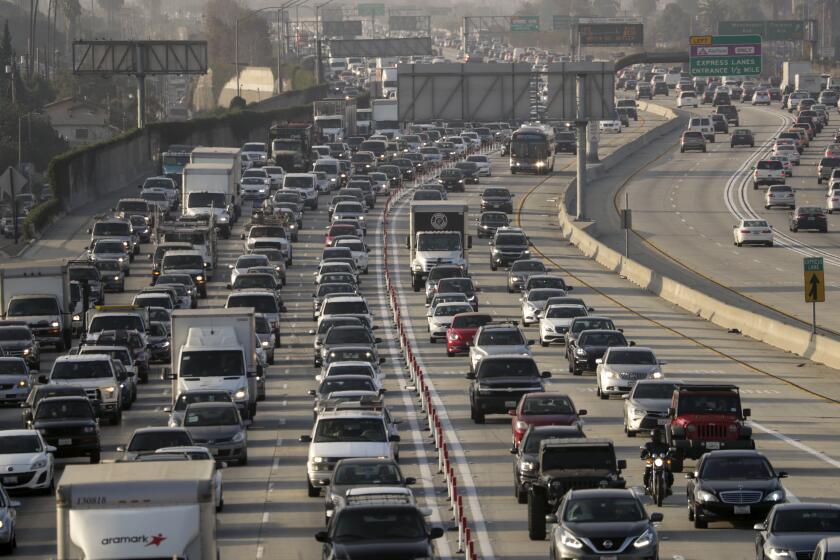COVID-19 helped slash 2020’s carbon dioxide emissions. How will we keep it going?

The COVID-19 pandemic may have cut 2020’s global greenhouse gas emissions, but it won’t offer a lasting benefit unless similarly dramatic reductions in carbon dioxide continue for years to come, an international team of researchers says.
Their findings, published Wednesday in the journal Nature Climate Change, underscore the level of effort the U.S. and other nations will need to make to prevent the Earth’s temperature from rising further. It’s a lesson that policymakers will have to keep in mind as they start to rev up their economies once the pandemic wanes.
“The drop in CO2 emissions from responses to COVID-19 highlights the scale of actions and international adherence needed to tackle climate change,” wrote a team led by Corinne Le Quéré, who studies climate change at the University of East Anglica in England.
The nature of the economic disruptions — which particularly hit the transportation sector — also provide an opportunity to pivot toward more emissions-cutting practices, the researchers added. Perhaps policymakers can incentivize the large-scale deployment of electric vehicles and create more safe public space for walking and cycling in cities, they said.
“Strategic actions now could minimize the rebound and reinforce cuts in global emissions in the long term,” the authors wrote.
Since the Paris agreement was reached in 2015, the vast majority of the world’s countries promised to work together to limit global warming to under 2 degrees Celsius above preindustrial levels (and preferably to 1.5 degrees, if possible.)
But in the five years that followed, emissions cuts were relatively marginal: The United Nations issued a report late last year saying that even if countries hold to their commitments, the global temperature would still rise to 3.2 degrees Celsius above preindustrial levels by century’s end. Far more drastic cuts would be needed to contain global warming to the 1.5-to-2 degree range.
The pandemic, of course, did end up generating those drastic cuts, as local and national governments worldwide began issuing curfews, stay-home orders and restrictions on commerce.
Global carbon dioxide emissions fell by 2.6 billion metric tons in 2020, to 34 billion metric tons — a projected decrease that puts it at about 7% below 2019 levels, carbon-tracking research shows. It’s a startling drop, though one whose trajectory varied depending on the country’s income level.
The reductions are probably a short-lived effect of stay-at-home orders and the resulting economic downturn, and are bound to vanish with a COVID vaccine.
In high-income countries like the U.S., emissions had dropped by an average of 0.8% per year since the Paris agreement was reached in 2015. Then they tumbled 9% in 2020 thanks to the pandemic.
In a group of upper-middle-income countries, emissions had increased by an average annual rate of 0.8% since the Paris agreement, then dropped by 5% in 2020.
Among lower-income countries, emissions had actually been rising by an average of 4.5% a year since 2015. But then they plunged by 9% in 2020 — marking the sharpest relative decline of any group.
Regardless, one year of nose-diving emissions isn’t enough to make a serious long-term impact, Le Quéré and her coauthors wrote. To meet the Paris climate targets, the U.S. and the rest of the world will need to cut their emissions by about 1 billion to 2 billion metric tons per year — near-pandemic-level reductions — for every year throughout the 2020s.
Here’s the problem, they said: “Most current COVID-19 recovery plans are in direct contradiction with countries’ climate commitments.” For example, some efforts to get the post-COVID economy back on track include investing in fossil-fuel-based infrastructure.
If this year’s greenhouse gas reductions were a fleeting silver lining on an otherwise catastrophic cloud, how can countries achieve pandemic-level carbon dioxide cuts without suffering pandemic-level economic destruction?
They key, the authors said, is to ensure that post-pandemic growth is also tied to building a greener economy.
“Economic stimuli on national levels could soon change the course of global emissions if investments towards green infrastructure are enhanced while investments encouraging the use of fossil energy are reduced,” they wrote.
California’s plan to ban gas-powered cars in 15 years could become a model for the U.S. under Biden. But consumers aren’t clamoring for electric vehicles.
Emily Grubert, a civil and environmental engineer at Georgia Tech who was not involved in the new study, added that achieving these goals after the pandemic may feel daunting, but it’s doable. Folks can still go back to a life that feels “normal” after the pandemic — seeing friends and family, commuting to work and visiting restaurants and museums.
There are two main ways to reduce energy consumption, Grubert pointed out. First, people can use fewer services and thus less energy. That’s what the pandemic forced people to do, which turned out to be deeply disruptive to their lives.
The second option is to make those same services more energy-efficient, she said. Using less energy to provide the same services — whether by increasingly powering them with clean energy, or making them more energy-efficient — can have similar benefits, but with hardly any disruption.
“From a design perspective,” she said, the goal is to “use energy more efficiently, and more cleanly.”









